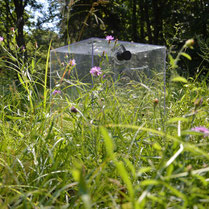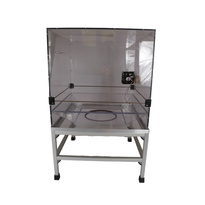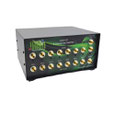Respiration Chambers for Gas Flux Measurements & Isotope Labelling

Ecosystem, Plant and Soil Respiration & Isotope Labelling Chambers. One approach to estimating ecosystem or plant respiration / gas exchange is to use airtight chambers, either (i) enclosing the whole ecosystem (e.g. a mesocosm, smaller plant communities such as grasslands) and directly providing the net ecosystem CO2 exchange (NEE), or (ii) chambers enclosing only a part of the ecosystem (e.g. plant, leaves, soil (soil respiration) etc.) and thus requiring some additional up-scaling. Isotope labelling also requires airtight plant or soil labelling chambers.
Custom-made Respiration Chambers

Gas Flux Chamber Systems, customised plant and ecosystem respiratory chambers for field, chamber and laboratory use, constructed of transparent polycarbonate or PMMA in various sizes and geometries. If required, a modular design allows the chamber size to be increased as the plant grows. In specific, in closed chamber settings the volume can be varied by modules to make sure that the rate of increase of a gas (e.g. CO2) is small enough to avoid problems related to gas (CO2) build-up during the measurement of the flux while being well above the limits of accuracy of the CO2 gas analyser, O2 sensor, or methane analyser. Gaskets around each collar (and the hole in the baseplate, when a mesocosm is used) ensure adequate gas tightness. For field use, a metal frame can be installed along the chambers sites to ensure gas tightness to the soil. Chamber air can be homogenized by one or more adjustable (direction and speed) fans; fan size, speed and angle can be adjusted to avoid interfering with plants or measurements. A range of pipe fittings/connection plates are available for common commercial IRGA systems. A gas control system can be added, or appropriate positions for entering cables or fixing your own sensors can be foreseen.
Various different plant and soil chamber types are custom build:
- Ecosystem Respiration chambers for measurements on grasslands, croplands and forest plots in situ.
- Respiration Chambers for mesocosms or large pots for measurements under controlled conditions, e.g. placement in growth chambers. Those chambers can also be a combination of respiration chambers and insect rearing cages to allow for experimentation on plant-insect interactions
- Smaller chamber systems for pots, growth tubes, or soil ("soil respiration chambers").
- Respiratory chambers to be used for isotope labelling.
Plant and Soil Chambers - features
- for gas exchanges measurements of plant communities, potted plants, soil etc.
- field, growth room and laboratory use
- fully customized, size, geometry, connectors (design ideas below)
- internal fan for enhanced air homogenisation
- compatible with all gas analyser systems
Optional
- matching gas analysers CO2, O2, Ch4, H2
- chamber switching systems (2–4 or 2–8 chambers)
- gas concentration control system
- Teflon chambers for reactive gases and BVOCs etc.
As all plant and soil chambers and related gas analyser / control systems are custom-built, please include a description or sketch of your desired design, and we will be happy to arrange a meeting to discuss the details.
Read more on special PTFE/Teflon reactive flux chambers for plant / environmental experimentation with reactive gases such as ozone, and/or volatiles.
When working with Rhizoboxes, dedicated Rhizobox Respiration Chambers allow for gas flux measurements and isotope labelling.
For applications requiring switching between 4 or 8 respiration chambers in open or stop flow modes, we offer versatile gas multiplexing systems.
Considerations for Gas Flux Chamber Designs
- There are a number of important considerations when designing a bespoke gas flow measurement chamber (also known as a 'breathing chamber'), but in brief these are ... Continue reading
-
- Chamber size and shape: The chamber should be large enough to provide sufficient headspace for gas exchange, but small enough to fit over the study area. Smaller chamber generally allow for faster detection of changing gas concentration in closed setups. The shape of the respiration chamber should be appropriate for the study system, whether it's a circular, square or rectangular shape for rhizoboxes, pots or vegetation plots in situ. An internal fan may help to homogenise the air within larger sized chamber (consider the limited pump speed of externally connected devices such as IRGAs).
- Chamber materials: The chamber material should be as inert, non-reactive as possible and often transparent (for plant studies). Acrylic (PMMA) is a commonly used material for chambers. Other suitable materials are glass, polycarbonate or PET/PTFE (for measurements of reactive substances incl. volatiles). Consider the reduction of radiation (PAR) by any transparent material - and the consequences for photosynthetic assimilation.
- Gas-tight seal: A gas-tight seal in closed chamber approaches is required to prevent loss or gain of gases from the chamber. Sealing can be achieved by the use of O-rings or gaskets and a clamp or screw system to hold the chamber in place. For field use, metal connection plates are often used at the bottom of the closed chambers, inserted a few centimetres into the ground. To avoid the build-up of overpressure, a pressure vent should be considered (this can be a tiny needle or a tube connected to a bottle of water).
- Gas sampling ports: Sampling ports allow the online measurement of gas concentrations within the chamber using common analysers, e.g. IRGA, Picarro, or the collection of gas alliquots in evacuated vials or sorbent tubes. The sampling ports on respiration chambers should be positioned at an appropriate position within the chamber and may be fitted with tubing for syringes, devices for automatic gas collection, or gas analyzers. Appropriate diffusers and spacing, together with internal mixing (particularly in larger chambers), will prevent inflow/outflow loops and inhomogeneous samples. Tubing on the inside of ports allows to position the air inlet and outlets at specific positions within larger chambers.
- Manipulation: Potentially insets of gas-tights gloves and airlocks (to enter tools or remove samples) can be useful to manipulate the chamber content, e.g. plants, while the respiration chamber is remaining closed. This is particular important when using the chambers for long term isotope labeling or to prevent insects (in combined insect-plant experimental cages) to escape.
- Environment: Environmental variables such as temperature, humidity, pressure and light intensity can greatly affect organisms and thus gas flow measurements. A fully functional respiratory chamber should thus include sensors to monitor these variables, such as a temperature probe, humidity sensor and light sensor. In a closed chamber system operated over longer periods, monitoring of CO2 and O2 is required. Take appropriate measures to control environmental variables by placing chambers in growth rooms / regulate chamber temperature with cooling coils, scrubbing CO2 and/or water (Dryrite, Peltier elements, etc.) or use dedicated Gas Mixing or Control Systems.
Overall, the construction of a gas flux / respiration chamber requires careful consideration of the materials used and environmental factors relevant in the study. Consultation with Vienna Scientific in cooperation with Qubit Systems can be helpful to ensure that the chamber design meets your specific research objectives.
| References |
Ecosystem Respiration Chambers and Gas Flux Measurements |
OPEN |
|
||
13C Isotope Labeling Chambers

Custom-made Isotope Labelling Chambers. Two types of labelling chamber set-ups for plants are generally used with 13C stable isotopes. The first type is commercially available, automatic cultivation chambers with a built-in regulation module for environmental parameters such as light, temperature and humidity. The second type, as offered by Vienna Scientific, makes use of custom-made labelling chambers placed in growth chambers or glasshouses which external light, temperature, and gas concentration regulation. Both approaches equally enable continuous monitoring and regulation of atmospheric parameters during labelling. Commonly conducted enrichment of other isotopes such as 15N or 34S does not require closed systems, but systems allowing to add labelled liquids. Generally, both equipment types are suitable to perform pulse labelling and uniformly, long-term labelling of plants towards different isotope enrichment.
- The specific design of the isotope labeling chamber will depend on the type of isotope(s) you wish to use and the specific experimental protocol you wish to follow. However, here are some general guidelines Vienna Scientific will follow to support the development of an isotope labeling chamber suiting your needs - analogue to the recomendation for respiration chambers (see above): Continue reading
-
- Select a chamber design: Different chamber designs are available depending on your research requirements. A typical design is a clear, airtight chamber that can hold a single plant or a group of plants. The chamber should have at least one inlet for introducing the labeled gas or solution and an outlet for removing excess gas. Other connections are beneficial.
- Monitor and control the environment: It is important to maintain or at least monitor the temperature, humidity and CO2 concentration within the chamber. This can be achieved by using sensors and controllers to regulate the environment. Vienna Scientific can assist you in sourcing the appropriate sensors, fans, scrubbers and/or provide a design that allows existing sensors to be installed in the new chamber.
- Build the labeling chamber: We will then construct the chamber using PMMA or polycarbonate. The chamber will be airtight to maintain the labeled environment, contain a positive pressure exhaust and all connectors needed to install sensors inside, water plants etc.
- Develop the gas mixer, tubing: If more than one gas cylinder is used to supply the isotopes, an appropriate mixer must be added before the air reaches the experimental isotope chamber. VSI will assist in the procurement of this chamber, flow meters, etc.
See above concerning further general recommendation for respiration chamber designs. Contact us to discuss possible isotope labeling chamber designs that meet your scientific objectives.
| References | Isotope Labeling Chambers | OPEN |
|
||
Gas mixing and control units are essential for any isotope labelling chamber and for long-term gas monitoring in closed chamber systems.
For a large selection of related gas measurement devices and tools, see e.g. CO2, O2, CH4 and O2 Gas Analysers, Flow Monitors & Pumps, Pressure Sensor, etc.
For determining the metabolic rate of aquatic animals in (custom) respirometry chambers with water, the Q-AQUA Aquatic Animal Respirometry System and alternative set-ups are available.















